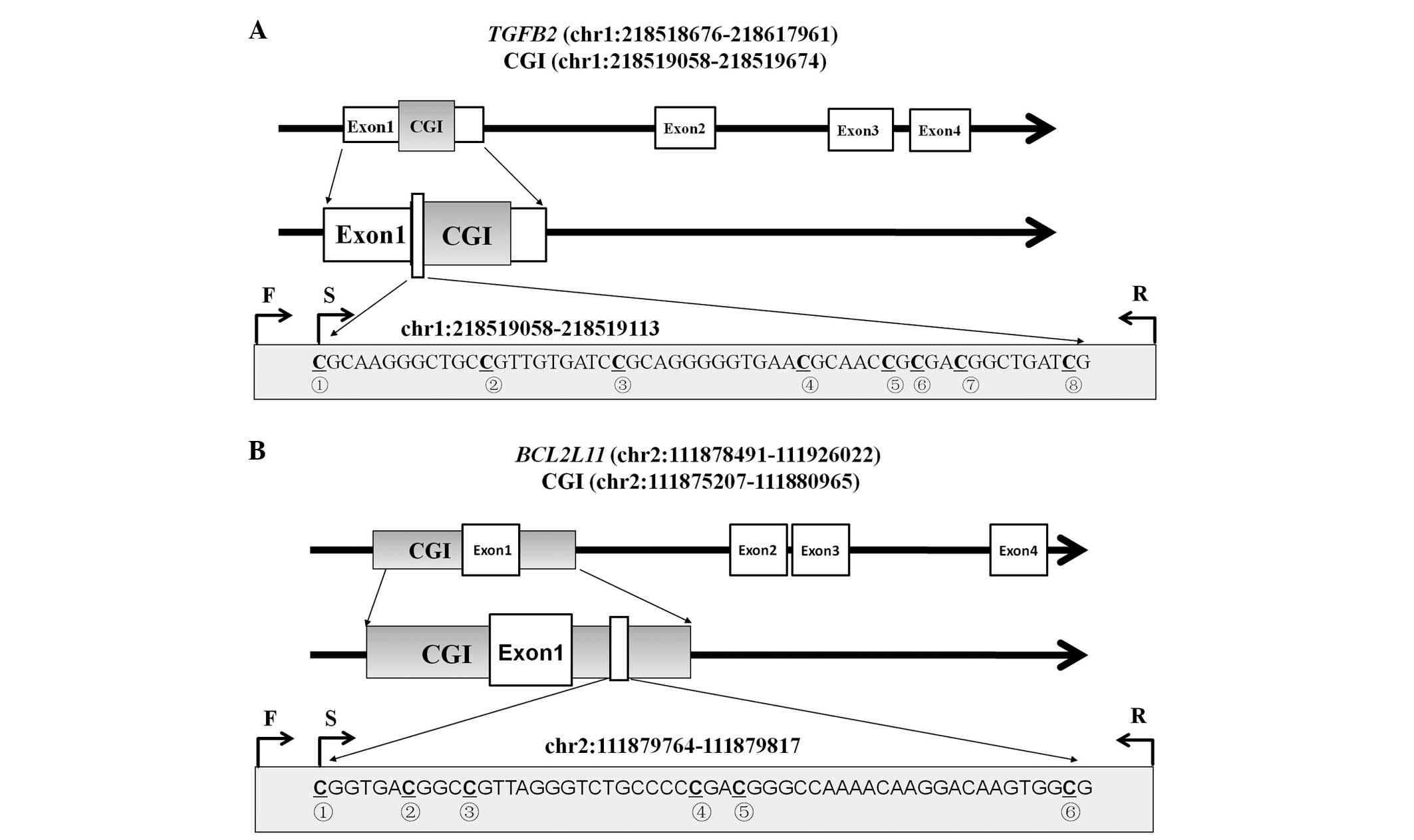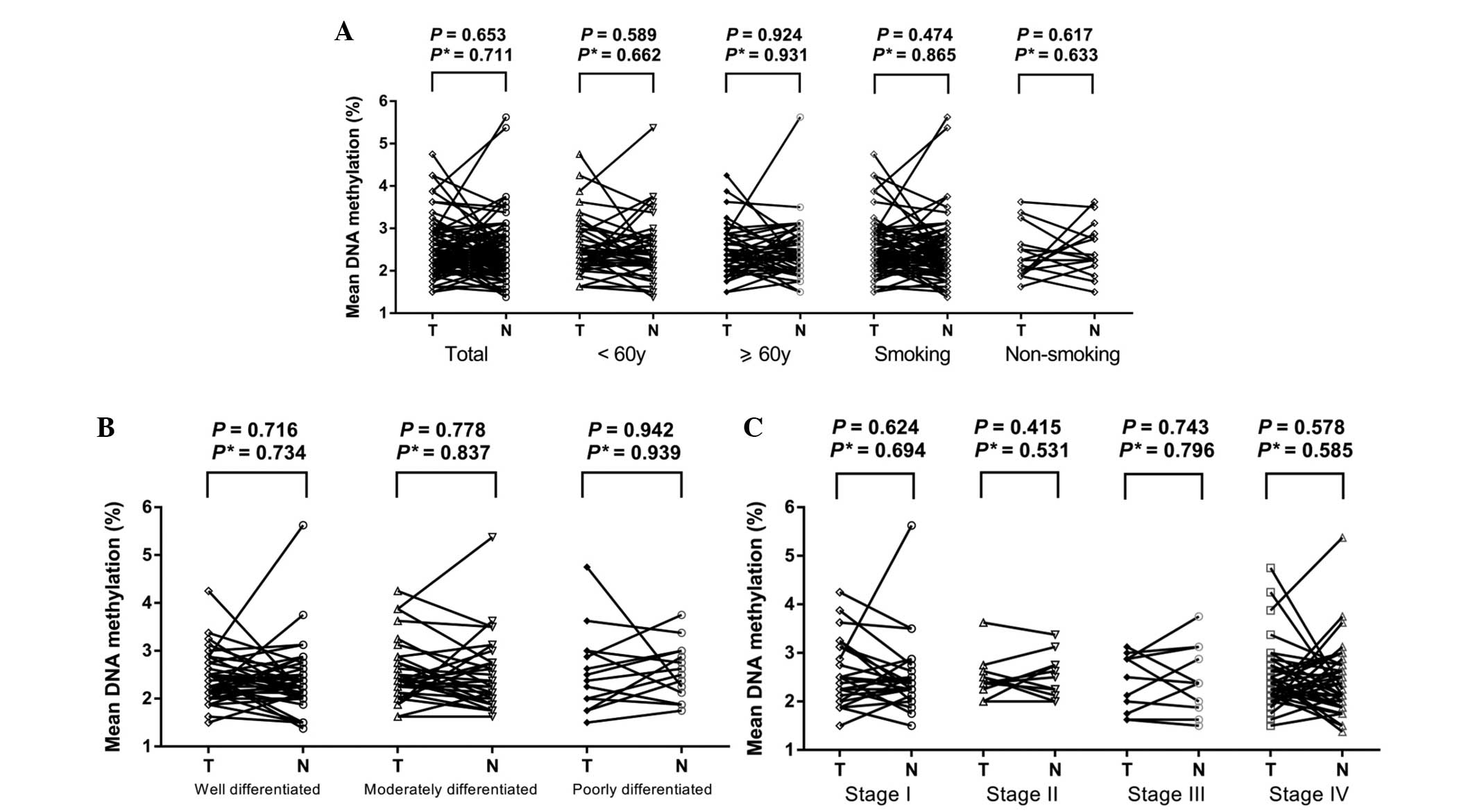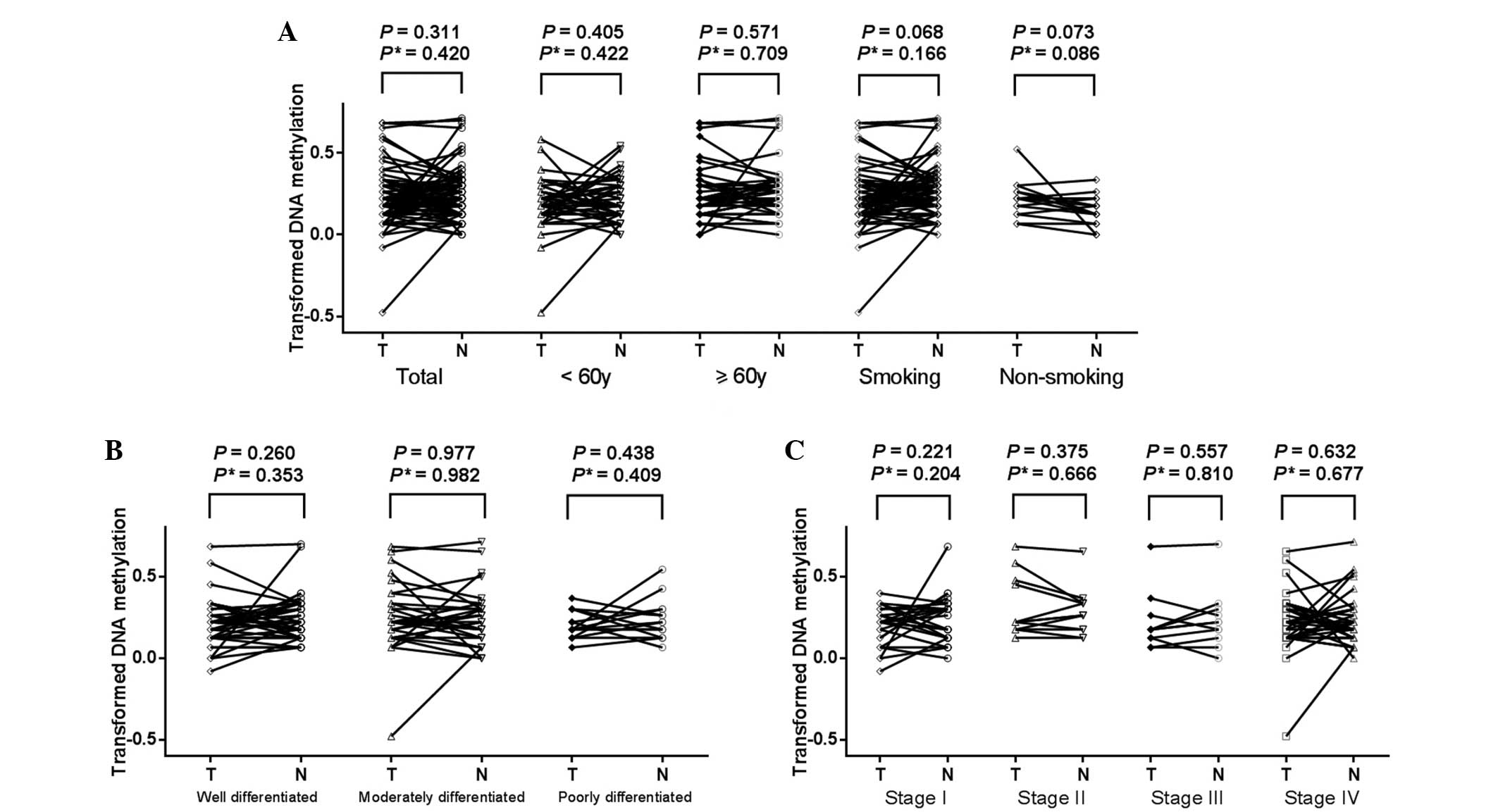TGFB2 and BCL2L11 methylation in male laryngeal cancer patients
- Authors:
- Published online on: August 16, 2016 https://doi.org/10.3892/ol.2016.5018
- Pages: 2999-3003
Abstract
Introduction
Laryngeal squamous cell carcinoma (LSCC) is the second most common head and neck cancer in the world (1). The incidence of LSCC in China has exhibited an increasing trend in the young population (2,3). LSCC is a complex disease, and it is hypothesized that both genetic and environmental factors play a role in it (4). Epigenetic modifications, including DNA methylation, are known as the bridging factors of genetics and the environment (5). However, the role of epigenetic modifications in the pathogenesis and progression of LSCC remains to be explained.
DNA methylation of CpG islands (CGIs) is a significant regulatory mechanism of gene expression (6). Epigenetic silencing of tumor suppressor genes by promoter hypermethylation is considered to be a significant event in the progression of cancers including leukemia (7), lung cancer (8) and prostate cancer (9). Gene-body methylation levels are also demonstrated to be correlated with gene expression (10,11).
TGFB2 is a member of the transforming growth factor β (TGFB) family, which encodes multifunctional peptides in the regulation of cell proliferation, differentiation, adhesion and migration (12). TGFB is able to inhibit tumor growth at the early stages and promote tumor growth at the late stages of disease (13). A previous study has demonstrated that increased TGFB2 promoter methylation level is associated with prostate cancer progression (14). BCL2L11 encodes a member of the BCL-2 (B cell lymphoma 2) protein family, which acts as an apoptotic activator that is involved in a wide variety of cellular activities (15). BCL2L11 methylation has been noted to be associated with the risk of hematological and epithelial cancers (16).
In the current study, the methylation levels of TGFB2 and BCL2L11 were investigated in male laryngeal cancer patients to determine whether these epigenetic markers are associated with LSCC risk.
Materials and methods
Tissue samples
LSCC and adjacent tissues were collected from 90 male patients (mean age, 60.5±8.65 years) who had undergone surgical treatment at the Department of Otolaryngology at Ningbo Lihuili Hospital, Zhejiang, China. The 90 tumors consisted of 43 well-differentiated cases, 32 moderately differentiated cases and 15 poorly differentiated cases. Among the LSCC patients, there were 27 stage I, 14 stage II, 11 stage III and 38 stage IV patients. All specimens were obtained freshly during the surgery and stored at −80°C. Permission was obtained from the bioethics committee at Ningbo Lihuili Hospital. All patients signed informed consent forms.
DNA bisulfite treatment and pyrosequencing analysis
Genomic DNA was isolated from tumor samples and then quantified as previously described (11,17). TGFB2 and BCL2L11 methylation levels were measured using bisulfite pyrosequencing technology. DNA conversion was performed using reagents provided in the Zymo EZ DNA Methylation-Gold kit (Zymo Research, Orange, CA, USA). The pyrosequencing procedures were performed as described previously (11,17). The primer sequences of TGFB2 were 5′-GAGTAATTTTAAGTTGGGGAGAAGTTAGT-3′ for the forward primer, 5′-Biotin-ACTCCAAACCCCAACCCAACCA-3′ for the reverse primer, and 5′-CCAACCCAACCACAA-3′ for the sequencing primer. The primer sequences of BCL2L11 were 5′-GAGGAAGTTGTTGGAGGAGAAT-3′ for the forward primer, 5′-Biotin-ACCCTACCCATCCCTATAC-3′ for the reverse primer, and 5′-ATCCCCAAACCCAAT-3′ for the sequencing primer.
Statistical analyses
Statistical analyses were performed by PASW Statistics 18.0 software (SPSS Inc., Chicago, IL, USA). Logarithmic transformation was applied for the data deviated from normality. Analysis of variance was used to evaluate the association between the risk factors (age, smoking history, histological differentiation and clinical stage) and relative methylation rate difference. A paired sample t-test was applied to compare TGFB2 and BCL2L11 methylation between the LSCC and adjacent tissues. All P-values were adjusted by logistic regression. A two-tailed P<0.05 was considered to indicate a statistically significant difference. All figures were drawn using GraphPad Prism 6 software (GraphPad, San Diego, CA, USA).
Results
In the present study, we assessed the TGFB2 and BCL2L11 methylation levels in LSCC and their adjacent non-neoplastic tissues using bisulfite pyrosequencing technology. As shown in Fig. 1, the tested fragments were located in the CGIs of the TGFB2 promoter (chr1:218519058-218519113) and BCL2L11 gene-body (chr2:111879764-111879817). A total of eight and six CpG dinucleotides were measured for TGFB2 and BCL2L11, respectively. The mean methylation levels of the tested CpG sites were used to compare their differences between the LSCC tumor and the adjacent normal tissues.
Our results revealed that there were no statistically significant differences of the methylation levels of TGFB2 promoter (Fig. 2, P=0.653) and BCL2L11 gene-body (Fig. 3, P=0.311) between LSCC tissues and the paired normal tissues. Further tests demonstrated no change in the results when adjusted for age, smoking history, histological differentiation and clinical stage (all adjusted P>0.05). Moreover, there was no difference in the TGFB2 promoter or BCL2L11 gene-body methylation levels between tumor tissues and paired normal tissues in the breakdown analyses by age, smoking history, histological differentiation or clinical stage of the patients (Figs. 2 and 3, all P>0.05, data not shown).
Discussion
The aim of the present study was to determine whether DNA methylation of the TGFB2 promoter and BCL2L11 gene-body was associated with LSCC risk. Through a series of statistical analyses of these two genes, no clear correlation with laryngeal cancer was observed. Further subgroup tests by age, smoking history, histological differentiation and clinical stage also produced similar results.
Epigenetic modifications are central to tumorigenesis (18). In cancer cells, global hypomethylation is accompanied by hypermethylation of certain gene promoter CGIs (6). DNA methylation of the gene promoter region leads to gene silencing by blocking the binding of transcription factors or methyl-binding proteins (6), while a positive correlation has been observed in a variety of human tissue types between gene-body methylation and gene expression (10,19). As for LSCC, aberrant DNA methylation of tumor suppressor genes, including MGMT, CHD5, p16, p14, PTEN, MYCT1 and FHIT, has been reported (4,20–23). DNA methylation levels of the promoter and gene-body are relatively dynamic (24). However, there are no previous studies on gene-body methylation in LSCC.
TGFB2 promoter hypermethylation was first identified as a potential epigenetic marker of prostate cancer in whole genome methylation profiling studies (25). A previous study revealed that the gene suppression of TGFB2 was not associated with DNA methylation but with chromatin remodeling in breast cancer tissue samples (26). In the present study, we did not observe any association between TGFB2 methylation and LSCC, suggesting that there were other genetic or epigenetic modifications in LSCC.
The apoptosis-related gene BCL2LL1 has been noted to be hypermethylated in colon cancer (27), hematological and epithelial cancers (16). In addition, low BCL2L11 expression in chronic myeloid leukemia was ascribed to BCL2LL1 hypermethylation at the gene promoter (28). Due to the limitation of not identifying a suitable primer set to assess the promoter CGI of the BCL2LL1 gene, we selected the CGI in the gene-body region as an alternative. Although our study did not identify any significant association with BCL2L11 gene-body methylation, the contribution of other CGIs to LSCC risk remains to be explored.
In conclusion, our study suggests a lack of contribution of the TGFB2 promoter and BCL2L11 gene-body methylation to LSCC in male patients. However, this study was designed as a pilot study, and further investigations are required to confirm our findings.
Acknowledgements
The study was supported by grants from Zhejiang Provincial Natural Science Foundation of China (no. LY14H160003), the Scientific Innovation Team Project of Ningbo (no. 2012B2019), Ningbo Social Development Key Research Project (no. 2012C5015), Ningbo Natural Science Foundation (no. 2012A610208, 2012A610217 and 2013A610217), the Medical and Health Research Project of Zhejiang Province (no. 2012ZDA042) and the Medical and Health Training Project of Zhejiang Province (no. 2014PYA 017).
References
|
Morshed K, Polz-Dacewicz M, Szymański M and Polz D: Short-fragment PCR assay for highly sensitive broad-spectrum detection of human papillomaviruses in laryngeal squamous cell carcinoma and normal mucosa: clinico-pathological evaluation. Eur Arch Otorhinolaryngology. 265(Suppl 1): S89–S96. 2008. View Article : Google Scholar | |
|
Chen K, Song F, He M, Li H, Qian B, Zhang W, Wei Q and Hao X: Trends in head and neck cancer incidence in Tianjin, China, between 1981 and 2002. Head Neck. 31:175–182. 2009. View Article : Google Scholar : PubMed/NCBI | |
|
Cattaruzza MS, Maisonneuve P and Boyle P: Epidemiology of laryngeal cancer. Eur J Cancer B Oral Oncol. 32B:293–305. 1996. View Article : Google Scholar : PubMed/NCBI | |
|
Yang M, Li W, Liu YY, Fu S, Qiu GB, Sun KL and Fu WN: Promoter hypermethylation-induced transcriptional down-regulation of the gene MYCT1 in laryngeal squamous cell carcinoma. BMC Cancer. 12:2192012. View Article : Google Scholar : PubMed/NCBI | |
|
Toporcov TN, Znaor A, Zhang ZF, Yu GP, Winn DM, Wei Q, Vilensky M, Vaughan T, Thomson P, Talamini R, et al: Risk factors for head and neck cancer in young adults: a pooled analysis in the INHANCE consortium. Int J Epidemiol. 44:169–185. 2015. View Article : Google Scholar : PubMed/NCBI | |
|
Laird PW: Cancer epigenetics. Hum Mol Genet. 14:R65–R76. 2005. View Article : Google Scholar : PubMed/NCBI | |
|
Jiang D, Hong Q, Shen Y, Xu Y, Zhu H, Li Y, Xu C, Ouyang G and Duan S: The diagnostic value of DNA methylation in leukemia: a systematic review and meta-analysis. PloS One. 9:e968222014. View Article : Google Scholar : PubMed/NCBI | |
|
Huang T, Chen X, Hong Q, Deng Z, Ma H, Xin Y, Fang Y, Ye H, Wang R, Zhang C, et al: Meta-analyses of gene methylation and smoking behavior in non-small cell lung cancer patients. Sci Rep. 5:88972015. View Article : Google Scholar : PubMed/NCBI | |
|
Jiang D, Shen Y, Dai D, Xu Y, Xu C, Zhu H, Huang T and Duan S: Meta-analyses of methylation markers for prostate cancer. Tumour Biol. 35:10449–10455. 2014. View Article : Google Scholar : PubMed/NCBI | |
|
Aran D, Toperoff G, Rosenberg M and Hellman A: Replication timing-related and gene body-specific methylation of active human genes. Hum Mol Genet. 20:670–680. 2011. View Article : Google Scholar : PubMed/NCBI | |
|
Xu L, Zheng D, Wang L, Jiang D, Liu H, Xu L, Liao Q, Zhang L, Liu P, Shi X, et al: GCK gene-body hypomethylation is associated with the risk of coronary heart disease. Biomed Res Int. 2014:1517232014. View Article : Google Scholar : PubMed/NCBI | |
|
Sporn MB and Roberts AB: Transforming growth factor-beta: recent progress and new challenges. J Cell Biol. 119:1017–1021. 1992. View Article : Google Scholar : PubMed/NCBI | |
|
Bierie B and Moses HL: Tumour microenvironment: TGFbeta: the molecular Jekyll and Hyde of cancer. Nat Rev Cancer. 6:506–520. 2006. View Article : Google Scholar : PubMed/NCBI | |
|
Liu L, Kron KJ, Pethe VV, Demetrashvili N, Nesbitt ME, Trachtenberg J, Ozcelik H, Fleshner NE, Briollais L, van der Kwast TH and Bapat B: Association of tissue promoter methylation levels of APC, TGFβ2, HOXD3 and RASSF1A with prostate cancer progression. Int J Cancer. 129:2454–2462. 2011. View Article : Google Scholar : PubMed/NCBI | |
|
Leo E, Mancini M, Aluigi M, Castagnetti F, Martinelli G, Barbieri E and Santucci MA: DNA hypermethylation promotes the low expression of pro-apoptotic BCL2L11 associated with BCR-ABL1 fusion gene of chronic myeloid leukaemia. Br J Haematol. 159:373–376. 2012. View Article : Google Scholar : PubMed/NCBI | |
|
Dunwell T, Hesson L, Rauch TA, Wang L, Clark RE, Dallol A, Gentle D, Catchpoole D, Maher ER, Pfeifer GP and Latif F: A genome-wide screen identifies frequently methylated genes in haematological and epithelial cancers. Mol Cancer. 9:442010. View Article : Google Scholar : PubMed/NCBI | |
|
Tang L, Ye H, Hong Q, Wang L, Wang Q, Wang H, Xu L, Bu S, Zhang L, Cheng J, et al: Elevated CpG island methylation of GCK gene predicts the risk of type 2 diabetes in Chinese males. Gene. 547:329–333. 2014. View Article : Google Scholar : PubMed/NCBI | |
|
Torrisani J, Hanoun N, Laurell H, Lopez F, Maoret JJ, Souque A, Susini C, Cordelier P and Buscail L: Identification of an upstream promoter of the human somatostatin receptor, hSSTR2, which is controlled by epigenetic modifications. Endocrinology. 149:3137–3147. 2008. View Article : Google Scholar : PubMed/NCBI | |
|
Ball MP, Li JB, Gao Y, Lee JH, LeProust EM, Park IH, Xie B, Daley GQ and Church GM: Targeted and genome-scale strategies reveal gene-body methylation signatures in human cells. Nat Biotechnol. 27:361–368. 2009. View Article : Google Scholar : PubMed/NCBI | |
|
Yang J, Zhu XB, He LX, Gu ZW, Jin MZ and Ji WY: Clinical significance of epigenetic silencing and re-expression of O6-methylguanine-DNA methyltransferase using epigenetic agents in laryngeal carcinoma. Oncol Lett. 9:35–42. 2015.PubMed/NCBI | |
|
Kis A, Tatár TZ, Gáll T, Boda R, Tar I, Major T, Redl P, Gergely L and Szarka K: Frequency of genetic and epigenetic alterations of p14ARF and p16INK4A in head and neck cancer in a Hungarian population. Pathol Oncol Res. 20:923–929. 2014. View Article : Google Scholar : PubMed/NCBI | |
|
Wang J, Chen H, Fu S, Xu ZM, Sun KL and Fu WN: The involvement of CHD5 hypermethylation in laryngeal squamous cell carcinoma. Oral Oncol. 47:601–608. 2011. View Article : Google Scholar : PubMed/NCBI | |
|
Yin D and Dong M: Methylation of promoter and expression of FHIT gene in laryngeal squamous cell carcinoma. Lin Chuang Er Bi Yan Hou Ke Za Zhi. 19:253–255, 258. 2005.(In Chinese). PubMed/NCBI | |
|
Suzuki MM and Bird A: DNA methylation landscapes: provocative insights from epigenomics. Nat Rev Genet. 9:465–476. 2008. View Article : Google Scholar : PubMed/NCBI | |
|
Kron K, Pethe V, Briollais L, Sadikovic B, Ozcelik H, Sunderji A, Venkateswaran V, Pinthus J, Fleshner N, van der Kwast T and Bapat B: Discovery of novel hypermethylated genes in prostate cancer using genomic CpG island microarrays. PloS One. 4:e48302009. View Article : Google Scholar : PubMed/NCBI | |
|
Hinshelwood RA, Huschtscha LI, Melki J, Stirzaker C, Abdipranoto A, Vissel B, Ravasi T, Wells CA, Hume DA, Reddel RR and Clark SJ: Concordant epigenetic silencing of transforming growth factor-beta signaling pathway genes occurs early in breast carcinogenesis. Cancer Res. 67:11517–11527. 2007. View Article : Google Scholar : PubMed/NCBI | |
|
Cho Y, Turner ND, Davidson LA, Chapkin RS, Carroll RJ and Lupton JR: Colon cancer cell apoptosis is induced by combined exposure to the n-3 fatty acid docosahexaenoic acid and butyrate through promoter methylation. Exp Biol Med (Maywood). 239:302–310. 2014. View Article : Google Scholar : PubMed/NCBI | |
|
San Jose-Eneriz E, Agirre X, Jimenez-Velasco A, Cordeu L, Martín V, Arqueros V, Gárate L, Fresquet V, Cervantes F, Martínez-Climent JA, et al: Epigenetic down-regulation of BIM expression is associated with reduced optimal responses to imatinib treatment in chronic myeloid leukaemia. Eur J Cancer. 45:1877–1889. 2009. View Article : Google Scholar : PubMed/NCBI |













